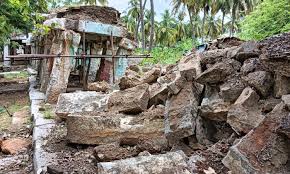Hampi : In News

A mandapa at Virupaksha Temple collapsed due to heavy rain, sparking concerns over neglect.
- Hampi was the capital city of the Vijayanagara Empire, established in 1336 CE by Harihara I and Bukka Raya I of the Sangama Dynasty.
- Traditionally known as Pampakshetra of Kishkindha, Hampi is located in central Karnataka on the banks of the Tungabhadra River.
- Foreign travellers like Domingo Paes described Vijayanagara as “as large and beautiful as Rome”, highlighting its architectural grandeur and prosperity.
- The empire fell in 1565 CE after the Battle of Talikota, where the Deccan Sultanates defeated Rama Raya, leading to mass destruction.
- The city reportedly burned for six months.
- Hampi remained forgotten until the late 18th century when British antiquarian Colin Mackenzie mapped it in 1799, creating the first cartographic records.
- Early photographs and restoration attempts were made by British officials like Alexander Greenlaw, showcasing colonial-era interest in Indian heritage.
- The first major conservation initiative, the Hampi National Project, was launched in 1976.
- Excavations revealed key sites such as the Vitthala Temple bazaar, Pushkarini (stepped tank), and Paan-supari bazaar.
- Prominent landmarks include the Virupaksha Temple, Lotus Mahal, Queen’s Bath, and Elephant Stables.
- Hampi was declared a UNESCO World Heritage Site in 1986, recognising it as one of India’s largest archaeological zones, covering 250 sq. km and housing over 1,600 monuments.




